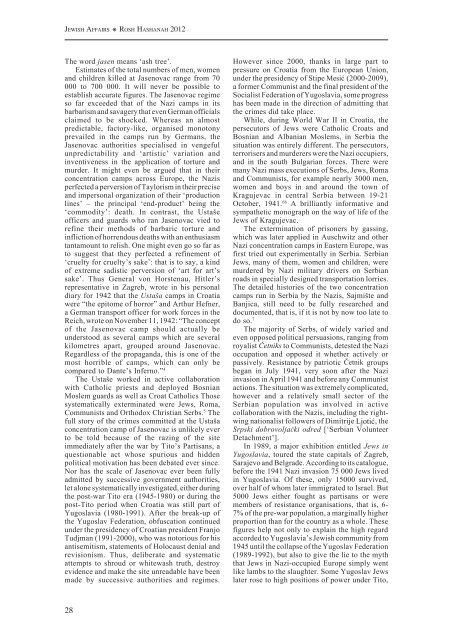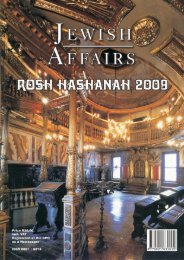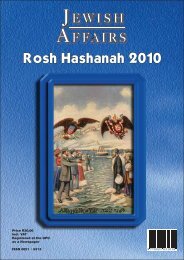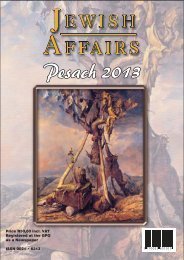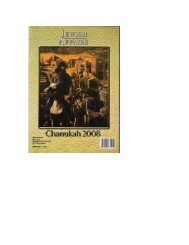Jewish Affairs - South African Jewish Board of Deputies
Jewish Affairs - South African Jewish Board of Deputies
Jewish Affairs - South African Jewish Board of Deputies
- No tags were found...
Create successful ePaper yourself
Turn your PDF publications into a flip-book with our unique Google optimized e-Paper software.
JEWISH AFFAIRS ROSH HASHANAH 2012The word jasen means ‘ash tree’.Estimates <strong>of</strong> the total numbers <strong>of</strong> men, womenand children killed at Jasenovac range from 70000 to 700 000. It will never be possible toestablish accurate figures. The Jasenovac regimeso far exceeded that <strong>of</strong> the Nazi camps in itsbarbarism and savagery that even German <strong>of</strong>ficialsclaimed to be shocked. Whereas an almostpredictable, factory-like, organised monotonyprevailed in the camps run by Germans, theJasenovac authorities specialised in vengefulunpredictability and ‘artistic’ variation andinventiveness in the application <strong>of</strong> torture andmurder. It might even be argued that in theirconcentration camps across Europe, the Nazisperfected a perversion <strong>of</strong> Taylorism in their preciseand impersonal organization <strong>of</strong> their ‘productionlines’ – the principal ‘end-product’ being the‘commodity’: death. In contrast, the Ustaše<strong>of</strong>ficers and guards who ran Jasenovac vied torefine their methods <strong>of</strong> barbaric torture andinfliction <strong>of</strong> horrendous deaths with an enthusiasmtantamount to relish. One might even go so far asto suggest that they perfected a refinement <strong>of</strong>‘cruelty for cruelty’s sake’: that is to say, a kind<strong>of</strong> extreme sadistic perversion <strong>of</strong> ‘art for art’ssake’. Thus General von Horstenau, Hitler’srepresentative in Zagreb, wrote in his personaldiary for 1942 that the Ustaša camps in Croatiawere “the epitome <strong>of</strong> horror” and Arthur Hefner,a German transport <strong>of</strong>ficer for work forces in theReich, wrote on November 11, 1942: “The concept<strong>of</strong> the Jasenovac camp should actually beunderstood as several camps which are severalkilometres apart, grouped around Jasenovac.Regardless <strong>of</strong> the propaganda, this is one <strong>of</strong> themost horrible <strong>of</strong> camps, which can only becompared to Dante’s Inferno.” 4The Ustaše worked in active collaborationwith Catholic priests and deployed BosnianMoslem guards as well as Croat Catholics Thosesystematically exterminated were Jews, Roma,Communists and Orthodox Christian Serbs. 5 Thefull story <strong>of</strong> the crimes committed at the Ustašaconcentration camp <strong>of</strong> Jasenovac is unlikely everto be told because <strong>of</strong> the razing <strong>of</strong> the siteimmediately after the war by Tito’s Partisans, aquestionable act whose spurious and hiddenpolitical motivation has been debated ever since.Nor has the scale <strong>of</strong> Jasenovac ever been fullyadmitted by successive government authorities,let alone systematically investigated, either duringthe post-war Tito era (1945-1980) or during thepost-Tito period when Croatia was still part <strong>of</strong>Yugoslavia (1980-1991). After the break-up <strong>of</strong>the Yugoslav Federation, obfuscation continuedunder the presidency <strong>of</strong> Croatian president FranjoTudjman (1991-2000), who was notorious for hisantisemitism, statements <strong>of</strong> Holocaust denial andrevisionism. Thus, deliberate and systematicattempts to shroud or whitewash truth, destroyevidence and make the site unreadable have beenmade by successive authorities and regimes.However since 2000, thanks in large part topressure on Croatia from the European Union,under the presidency <strong>of</strong> Stipe (2000-2009),a former Communist and the final president <strong>of</strong> theSocialist Federation <strong>of</strong> Yugoslavia, some progresshas been made in the direction <strong>of</strong> admitting thatthe crimes did take place.While, during World War II in Croatia, thepersecutors <strong>of</strong> Jews were Catholic Croats andBosnian and Albanian Moslems, in Serbia thesituation was entirely different. The persecutors,terrorisers and murderers were the Nazi occupiers,and in the south Bulgarian forces. There weremany Nazi mass executions <strong>of</strong> Serbs, Jews, Romaand Communists, for example nearly 3000 men,women and boys in and around the town <strong>of</strong>Kragujevac in central Serbia between 19-21October, 1941. 66 A brilliantly informative andsympathetic monograph on the way <strong>of</strong> life <strong>of</strong> theJews <strong>of</strong> Kragujevac.The extermination <strong>of</strong> prisoners by gassing,which was later applied in Auschwitz and otherNazi concentration camps in Eastern Europe, wasfirst tried out experimentally in Serbia. SerbianJews, many <strong>of</strong> them, women and children, weremurdered by Nazi military drivers on Serbianroads in specially designed transportation lorries.The detailed histories <strong>of</strong> the two concentrationcamps run in Serbia by the Nazis, Sajmište andBanjica, still need to be fully researched anddocumented, that is, if it is not by now too late todo so. 7The majority <strong>of</strong> Serbs, <strong>of</strong> widely varied andeven opposed political persuasions, ranging fromroyalist to Communists, detested the Nazioccupation and opposed it whether actively orpassively. Resistance by patriotic groupsbegan in July 1941, very soon after the Naziinvasion in April 1941 and before any Communistactions. The situation was extremely complicated,however and a relatively small sector <strong>of</strong> theSerbian population was involved in activecollaboration with the Nazis, including the rightwingnationalist followers <strong>of</strong> Dimitrije , theSrpski dobrovolja ki odred [‘Serbian VolunteerDetachment’].In 1989, a major exhibition entitled Jews inYugoslavia, toured the state capitals <strong>of</strong> Zagreb,Sarajevo and Belgrade. According to its catalogue,before the 1941 Nazi invasion 75 000 Jews livedin Yugoslavia. Of these, only 15000 survived,over half <strong>of</strong> whom later immigrated to Israel. But5000 Jews either fought as partisans or weremembers <strong>of</strong> resistance organisations, that is, 6-7% <strong>of</strong> the pre-war population, a marginally higherproportion than for the country as a whole. Thesefigures help not only to explain the high regardaccorded to Yugoslavia’s <strong>Jewish</strong> community from1945 until the collapse <strong>of</strong> the Yugoslav Federation(1989-1992), but also to give the lie to the myththat Jews in Nazi-occupied Europe simply wentlike lambs to the slaughter. Some Yugoslav Jewslater rose to high positions <strong>of</strong> power under Tito,28


